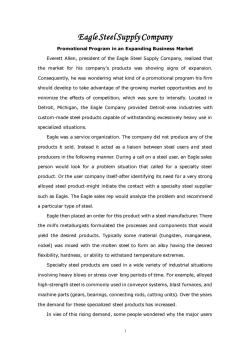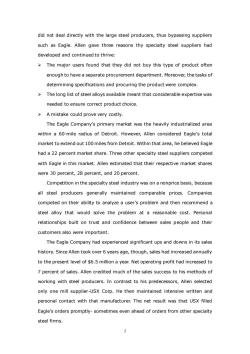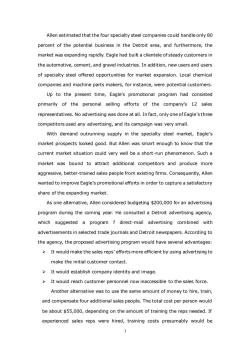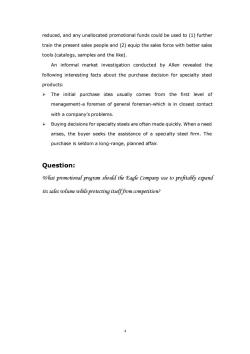《市场营销学》课程教学案例(双语)Egle Steel Supply Company

Eagle SteelSupply Company Promotional Program in an Expanding Business Market Everett Allen,president of the Eagle Steel Supply Company,realized that the market for his company's products was showing signs of expansion Consequently,he was wondering what kind of a promotional program his firm should develop to take advantage of the growing market opportunities and to minimize the effects of competition,which was sure to intensify.Located in Detroit,Michigan,the Eagle Company provided Detroit-area industries with custom-made steel products capable of withstanding excessively heavy use in specialized situations Eagle was a service organization.The company did not produce any of the products it sold.Instead it acted as a liaison between steel users and steel producers in the following manner.During a call on a steel user,an Eagle sales person would look for a problem situation that called for a specialty steel product.Or the user company itself-after identifying its need for a very strong alloyed steel product-might initiate the contact with a specialty steel supplier such as Eagle.The Eagle sales rep would analyze the problem and recommend a particular type of steel Eagle then placed an order for this product with a steel manufacturer.There the mill's metallurgists formulated the processes and components that would yield the desired products.Typically some material(tungsten,manganese, nickel)was mixed with the molten steel to fomm an alloy having the desired flexibility,hardness,or ability to withstand temperature extremes. Specialty steel products are used in a wide variety of industrial situations involving heavy blows or stress over long periods of time.For example,alloyed high-strength steel is commonly used in conveyor systems,blast furnaces,and machine parts(gears,bearings,connecting rods,cutting units).Over the years the demand for these specialized steel products has increased In vies of this rising demand,some people wondered why the major users
1 Eagle Steel Supply Company Promotional Program in an Expanding Business Market Everett Allen, president of the Eagle Steel Supply Company, realized that the market for his company’s products was showing signs of expansion. Consequently, he was wondering what kind of a promotional program his firm should develop to take advantage of the growing market opportunities and to minimize the effects of competition, which was sure to intensify. Located in Detroit, Michigan, the Eagle Company provided Detroit-area industries with custom-made steel products capable of withstanding excessively heavy use in specialized situations. Eagle was a service organization. The company did not produce any of the products it sold. Instead it acted as a liaison between steel users and steel producers in the following manner. During a call on a steel user, an Eagle sales person would look for a problem situation that called for a specialty steel product. Or the user company itself-after identifying its need for a very strong alloyed steel product-might initiate the contact with a specialty steel supplier such as Eagle. The Eagle sales rep would analyze the problem and recommend a particular type of steel. Eagle then placed an order for this product with a steel manufacturer. There the mill’s metallurgists formulated the processes and components that would yield the desired products. Typically some material (tungsten, manganese, nickel) was mixed with the molten steel to form an alloy having the desired flexibility, hardness, or ability to withstand temperature extremes. Specialty steel products are used in a wide variety of industrial situations involving heavy blows or stress over long periods of time. For example, alloyed high-strength steel is commonly used in conveyor systems, blast furnaces, and machine parts (gears, bearings, connecting rods, cutting units). Over the years the demand for these specialized steel products has increased. In vies of this rising demand, some people wondered why the major users

did not deal directly with the large steel producers,thus bypassing suppliers such as Eagle.Allen gave three reasons thy specialty steel suppliers had developed and continued to thrive: >The major users found that they did not buy this type of product often enough to have a separate procurement department.Moreover,the tasks of determining specifications and procuring the product were complex. The long list of steel alloys available meant that considerable expertise was needed to ensure correct product choice A mistake could prove very costly. The Eagle Company's primary market was the heavily industrialized area within a 60-mile radius of Detroit.However,Allen considered Eagle's total market to extend out 100 miles from Detroit.Within that area,he believed Eagle had a 22 percent market share.Three other specialty steel suppliers competed with Eagle in this market.Allen estimated that their respective market shares were 30 percent,28 percent,and 20 percent. Competition in the specialty steel industry was on a nonprice basis,because all steel producers generally maintained comparable prices.Companies competed on their ability to analyze a user's problem and then recommend a steel alloy that would solve the problem at a reasonable cost.Personal relationships built on trust and confidence between sales people and their customers also were important. The Eagle Company had experienced significant ups and downs in its sales history.Since Allen took over 6 years age,though,sales had increased annually to the present level of $6.5 million a year.Net operating profit had increased to 7 percent of sales.Allen credited much of the sales success to his methods of working with steel producers.In contrast to his predecessors,Allen selected only one mill supplier-USX Corp.He then maintained intensive written and personal contact with that manufacturer.The net result was that USX filled Eagle's orders promptly-sometimes even ahead of orders from other specialty steel firms
2 did not deal directly with the large steel producers, thus bypassing suppliers such as Eagle. Allen gave three reasons thy specialty steel suppliers had developed and continued to thrive: ➢ The major users found that they did not buy this type of product often enough to have a separate procurement department. Moreover, the tasks of determining specifications and procuring the product were complex. ➢ The long list of steel alloys available meant that considerable expertise was needed to ensure correct product choice. ➢ A mistake could prove very costly. The Eagle Company’s primary market was the heavily industrialized area within a 60-mile radius of Detroit. However, Allen considered Eagle’s total market to extend out 100 miles from Detroit. Within that area, he believed Eagle had a 22 percent market share. Three other specialty steel suppliers competed with Eagle in this market. Allen estimated that their respective market shares were 30 percent, 28 percent, and 20 percent. Competition in the specialty steel industry was on a nonprice basis, because all steel producers generally maintained comparable prices. Companies competed on their ability to analyze a user’s problem and then recommend a steel alloy that would solve the problem at a reasonable cost. Personal relationships built on trust and confidence between sales people and their customers also were important. The Eagle Company had experienced significant ups and downs in its sales history. Since Allen took over 6 years age, though, sales had increased annually to the present level of $6.5 million a year. Net operating profit had increased to 7 percent of sales. Allen credited much of the sales success to his methods of working with steel producers. In contrast to his predecessors, Allen selected only one mill supplier-USX Corp. He then maintained intensive written and personal contact with that manufacturer. The net result was that USX filled Eagle’s orders promptly- sometimes even ahead of orders from other specialty steel firms

Allen estimated that the four specialty steel companies could handle only 80 percent of the potential business in the Detroit area,and furthermore,the market was expanding rapidly.Eagle had built a clientele of steady customers in the automotive,cement,and gravel industries.In addition,new users and users of specialty steel offered opportunities for market expansion.Local chemical companies and machine parts makers,for instance,were potential customers. Up to the present time,Eagle's promotional program had consisted primarily of the personal selling efforts of the company's 12 sales representatives.No advertising was done at all.In fact,only one of Eagle's three competitors used any advertising,and its campaign was very small. With demand outrunning supply in the specialty steel market,Eagle's market prospects looked good.But Allen was smart enough to know that the current market situation could very well be a short-run phenomenon.Such a market was bound to attract additional competitors and produce more aggressive,better-trained sales people from existing firms.Consequently,Allen wanted to improve Eagle's promotional efforts in order to capture a satisfactory share of the expanding market. As one alternative,Allen considered,000 for an advertising program during the coming year.He consulted a Detroit advertising agency, which suggested a program f direct-mail advertising combined with advertisements in selected trade journals and Detroit newspapers.According to the agency,the proposed advertising program would have several advantages: It would make the sales reps'efforts more efficient by using advertising to make the initial customer contact. >It would establish company identity and image. >It would reach customer personnel now inaccessible to the sales force. Another alternative was to use the same amount of money to hire,train, and compensate four additional sales people.The total cost per person would be about $55,000,depending on the amount of training the reps needed.If experienced sales reps were hired,training costs presumably would be 3
3 Allen estimated that the four specialty steel companies could handle only 80 percent of the potential business in the Detroit area, and furthermore, the market was expanding rapidly. Eagle had built a clientele of steady customers in the automotive, cement, and gravel industries. In addition, new users and users of specialty steel offered opportunities for market expansion. Local chemical companies and machine parts makers, for instance, were potential customers. Up to the present time, Eagle’s promotional program had consisted primarily of the personal selling efforts of the company’s 12 sales representatives. No advertising was done at all. In fact, only one of Eagle’s three competitors used any advertising, and its campaign was very small. With demand outrunning supply in the specialty steel market, Eagle’s market prospects looked good. But Allen was smart enough to know that the current market situation could very well be a short-run phenomenon. Such a market was bound to attract additional competitors and produce more aggressive, better-trained sales people from existing firms. Consequently, Allen wanted to improve Eagle’s promotional efforts in order to capture a satisfactory share of the expanding market. As one alternative, Allen considered budgeting $200,000 for an advertising program during the coming year. He consulted a Detroit advertising agency, which suggested a program f direct-mail advertising combined with advertisements in selected trade journals and Detroit newspapers. According to the agency, the proposed advertising program would have several advantages: ➢ It would make the sales reps’ efforts more efficient by using advertising to make the initial customer contact. ➢ It would establish company identity and image. ➢ It would reach customer personnel now inaccessible to the sales force. Another alternative was to use the same amount of money to hire, train, and compensate four additional sales people. The total cost per person would be about $55,000, depending on the amount of training the reps needed. If experienced sales reps were hired, training costs presumably would be

reduced,and any unallocated promotional funds could be used to(1)further train the present sales people and(2)equip the sales force with better sales tools(catalogs,samples and the like). An informal market investigation conducted by Allen revealed the following interesting facts about the purchase decision for specialty steel products: The initial purchase idea usually comes from the first level of management-a foreman of general foreman-which is in closest contact with a company's problems. Buying decisions for specialty steels are often made quickly.When a need arises,the buyer seeks the assistance of a specialty steel firm.The purchase is seldom a long-range,planned affair. Question: What promotional program should the Eagle Company use to profitably expand its sales volume while protecting itself from competition?
4 reduced, and any unallocated promotional funds could be used to (1) further train the present sales people and (2) equip the sales force with better sales tools (catalogs, samples and the like). An informal market investigation conducted by Allen revealed the following interesting facts about the purchase decision for specialty steel products: ➢ The initial purchase idea usually comes from the first level of management-a foreman of general foreman-which is in closest contact with a company’s problems. ➢ Buying decisions for specialty steels are often made quickly. When a need arises, the buyer seeks the assistance of a specialty steel firm. The purchase is seldom a long-range, planned affair. Question: What promotional program should the Eagle Company use to profitably expand its sales volume while protecting itself from competition?
按次数下载不扣除下载券;
注册用户24小时内重复下载只扣除一次;
顺序:VIP每日次数-->可用次数-->下载券;
- 《市场营销学》课程教学案例(双语)Who will go to Saudi Arabia.doc
- 《市场营销学》课程教学案例(双语)Summit Ski Produc.doc
- 《市场营销学》课程教学案例(双语)Van Der Steen Candy Company.doc
- 《市场营销学》课程教学案例(双语)The Pepsi and Coca-Cola Challenge-A Cola with Breakfast.doc
- 《市场营销学》课程教学案例(中文)第1章案例 营销与营销管理-亚马逊名震全球之道.doc
- 《市场营销学》课程教学案例(中文)第2章案例 规划企业战略与市场营销管理-雅戈尔,选择没有对错.doc
- 《市场营销学》课程教学案例(中文)第4章案例 分析消费者市场与购买行为-小阿华的“精确营销”.doc
- 《市场营销学》课程教学案例(中文)第3章案例 市场营销环境-恒伟药业信息调研出效益.doc
- 《市场营销学》课程教学案例(中文)第5章案例 市场细分、决定目标市场与定位- “红高粱”的启示.doc
- 《市场营销学》课程教学案例(中文)第7章案例 价格决策-海信空调的价格策略.doc
- 《市场营销学》课程教学案例(中文)第6章案例 产品决策-广东太阳神的产品组合.doc
- 《市场营销学》课程教学案例(中文)第9章案例 促销策略-中国肥皂泡戏煞东瀛人.doc
- 《市场营销学》课程教学案例(中文)第8章案例 分销渠道策略-通用公司打造全球供应链.doc
- 《市场营销学》课程授课教案(双语)Chapter 1 Marketing.doc
- 《市场营销学》课程授课教案(双语)Chapter 3 Analyzing the Marketing Environment.doc
- 《市场营销学》课程授课教案(双语)Chapter 5 Consumer Markets and Consumer Buyer Behavior.doc
- 《市场营销学》课程授课教案(双语)Chapter 4 Managing Marketing Information to Gain Customer Insights.doc
- 《市场营销学》课程授课教案(双语)Chapter 2 Company and Marketing Strategy.doc
- 《市场营销学》课程授课教案(双语)Chapter 11 Communicating Customer Value.doc
- 《市场营销学》课程授课教案(双语)Chapter 8 Products, Services, and Brands.doc
- 《市场营销学》课程教学案例(双语)Selling Whoppers In Japan.doc
- 内蒙古科技大学:《市场营销学》课程作业习题(分章)市场营销学练习及答案(共九章).doc
- 内蒙古科技大学:《市场营销学》课程作业习题(综合)综合习题九.doc
- 内蒙古科技大学:《市场营销学》课程作业习题(综合)综合习题九答案.doc
- 内蒙古科技大学:《市场营销学》课程作业习题(综合)综合习题十.doc
- 内蒙古科技大学:《市场营销学》课程作业习题(综合)综合习题十答案.doc
- 内蒙古科技大学:《市场营销学》课程作业习题(综合)综合习题八答案.doc
- 内蒙古科技大学:《市场营销学》课程作业习题(综合)综合习题七答案.doc
- 内蒙古科技大学:《市场营销学》课程作业习题(综合)综合习题八.doc
- 内蒙古科技大学:《市场营销学》课程作业习题(综合)综合习题七.doc
- 内蒙古科技大学:《市场营销学》课程作业习题(综合)综合习题六.doc
- 内蒙古科技大学:《市场营销学》课程作业习题(综合)综合习题六答案.doc
- 内蒙古科技大学:《市场营销学》课程作业习题(综合)综合习题五.doc
- 内蒙古科技大学:《市场营销学》课程作业习题(综合)综合习题五答案.doc
- 内蒙古科技大学:《市场营销学》课程作业习题(综合)综合习题四答案.doc
- 内蒙古科技大学:《市场营销学》课程作业习题(综合)综合习题四.doc
- 内蒙古科技大学:《市场营销学》课程作业习题(综合)综合习题三答案.doc
- 内蒙古科技大学:《市场营销学》课程作业习题(综合)综合习题三.doc
- 内蒙古科技大学:《市场营销学》课程作业习题(综合)综合习题一答案.doc
- 内蒙古科技大学:《市场营销学》课程作业习题(综合)综合习题二答案.doc
